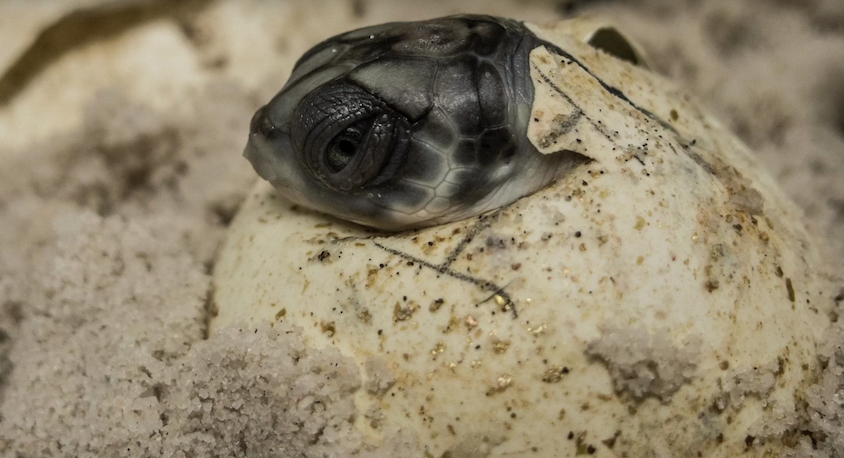Sea turtles are resilient creatures. Having survived for the last 110 million years, the seven different species have each thrived beneath Earth’s waters where they quietly support the health of ecosystems. But as temperatures continue to soar higher, have these marine reptiles finally met their match?
Climate change, specifically the warming of the earth, has been repeatedly deemed the most significant threat to humanity. Consequences aren’t necessarily immediately recognisable to the naked eye, however, nor do all feel repercussions equally. But that doesn’t mean it’s not present, leading to ocean acidification and droughts worldwide. If there’s any question about the validity of this, take a trip to Australia where these impacts have become tangible with no indication of slowing, let alone halting. “Climate model predictions predict that Australia is going to have a much higher increase in ambient temperatures than the rest of the world,” says Blair Bentley, an animal biology PhD candidate from University of Western Australia. “We’re expecting an increase of up to five degrees [Celsius], by the end of the century, which really is unprecedented.”
It’s not just the human population feeling the heat from a warming climate, however. The marine life is taking a considerable toll as well. One such species, sea turtles, are among those that are already endangered and now possibly heading toward extinction at an accelerated rate.
Like many other reptilian species, sea turtles have temperature-dependent sex determinations. In other words, the sex of the species depends on the temperature of the sand they are incubated within. Hotter sand and air means more females, while cooler sand and air means more males. With ambient temperatures rising, it’s expected for the number of female clutches to increase, which could result in an all-female sea turtle population. Further, if temperatures get too high, there is no hatching of the eggs at all. Both outcomes could prove to be lethal to the genus.
In Perth, a research team from the University of Western Australia in partnership with the Department of Parks and Wildlife are currently observing the changes occurring toward green and flatback sea turtles due to warming beaches.
As a whole, sea turtles are incredibly important to the Kimberly for a number of reasons. “They play a huge ecological role by maintaining the ecosystem and acting as a huge biomass in the ocean,” Bentley, a part of the UWA research team, explains.
Similar to the bleaching of the coral reefs along Australia’s coastline, the decline of this species will have a domino effect within the waters. “We know that the environment will change,” says Dr. Scott Whiting, a principle research scientist at the Department of Parks and Wildlife. “For example, a green turtle in a sea grass pasture has a major impact. It [the sea grass] looks like a mowed lawn. Once you take the species out, the sea grass gets quite long; full of epiphytes, and algae grows all over it. It’s a lot different environment.” The changes don’t stop there, though. An altered sea grass area could further result in changes to the types of invertebrates and species of fish that live within the areas. This then has an impact on other taxon including prawns and commercial fish. When you remove a major consumer, you risk shifting an entire environment.
Although the extinction of sea turtles in not likely to happen anytime immediately, the need to monitor this possibility is still a relevant cause for concern. “We have currently protected areas that are really linked to what the plants, animals and environment are now,” says Whiting. “We don’t really start to think about setting up protected areas in the future that we’ll have if turtles have to shift southwards toward a cooler environment.”
There’s no denying that it’s a daunting task to combat climate change. Changing and breaking habits is much more difficult that creating them. But as research continues to be released consistently confirming the assertion of a warming planet, arguably the worst course of action to take is eliminating research altogether – which is exactly what it appears the Commonwealth Scientific and Industrial Research Organisation (CSIRO) is doing. As the federally funded Australian company celebrates its 100th year of innovation, they are simultaneously halting research within climate programs by considering the elimination of the researchers focusing on climate modeling and monitoring. While the number of scientists poised to be released from the company seems to be in flux, there’s no doubt that cuts will continue. “I know this is a lot, and with finite resources, we must pick and choose where to prioritize,” stated CSIRO chief executive Dr. Larry Marshall in the leaked email that was sent to staff. “This means as we focus on new areas we must stop other areas.”
In the midst of this ongoing battle within the science community, the next steps toward mitigating climate change are less than complicated. “Stop emissions. Don’t cut climate scientists,” says Bentley. “We need a lot more research into climate change, so we need our scientists to be able to model and predict what’s going to happen.”
Leslie Cory is studying journalism at the University of California. She recently spent several weeks with a research team in Western Australia, observing the impacts of climate change on sea turtle populations. Watch her video, ‘Turtles in Distress’ on YouTube.


